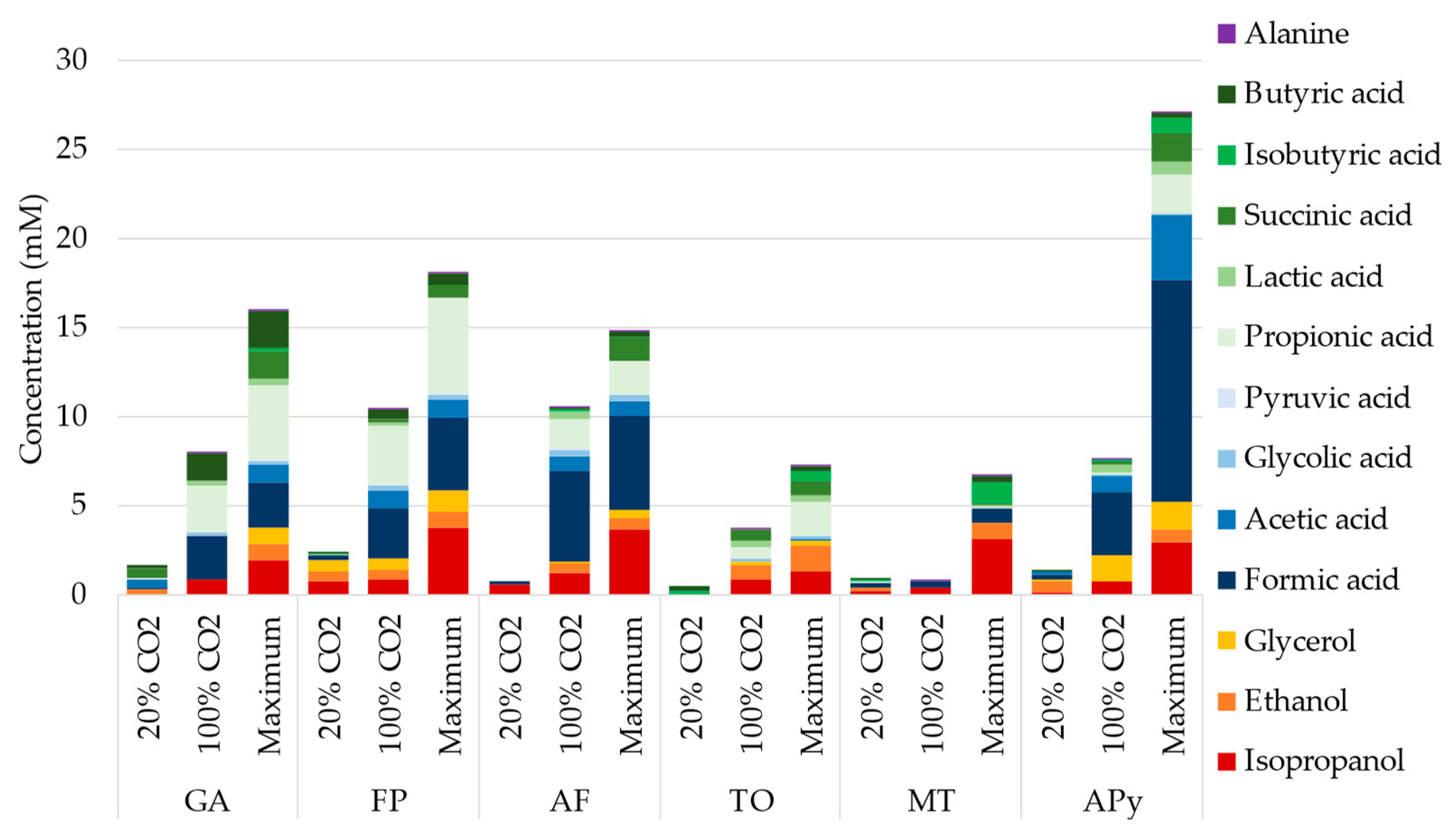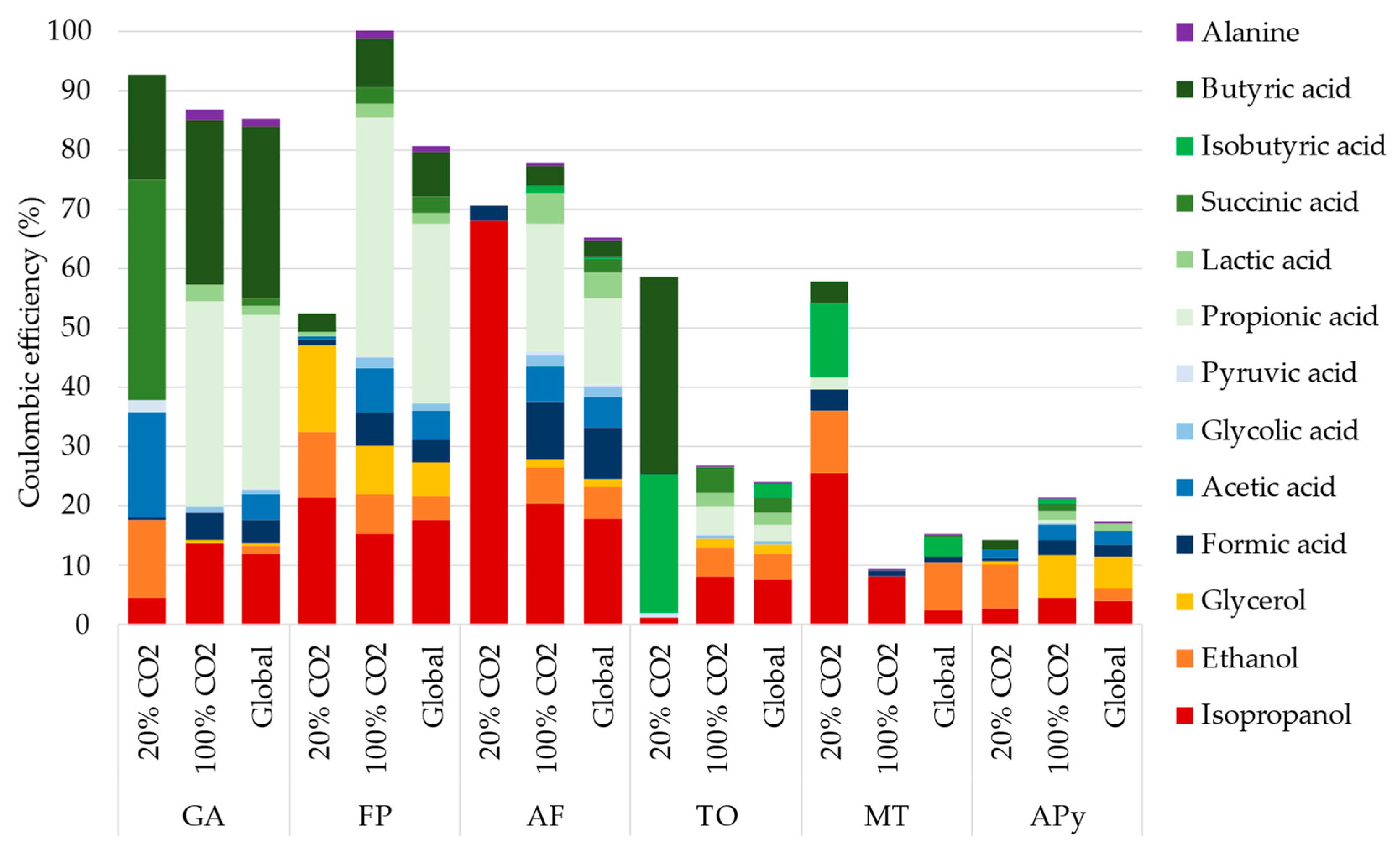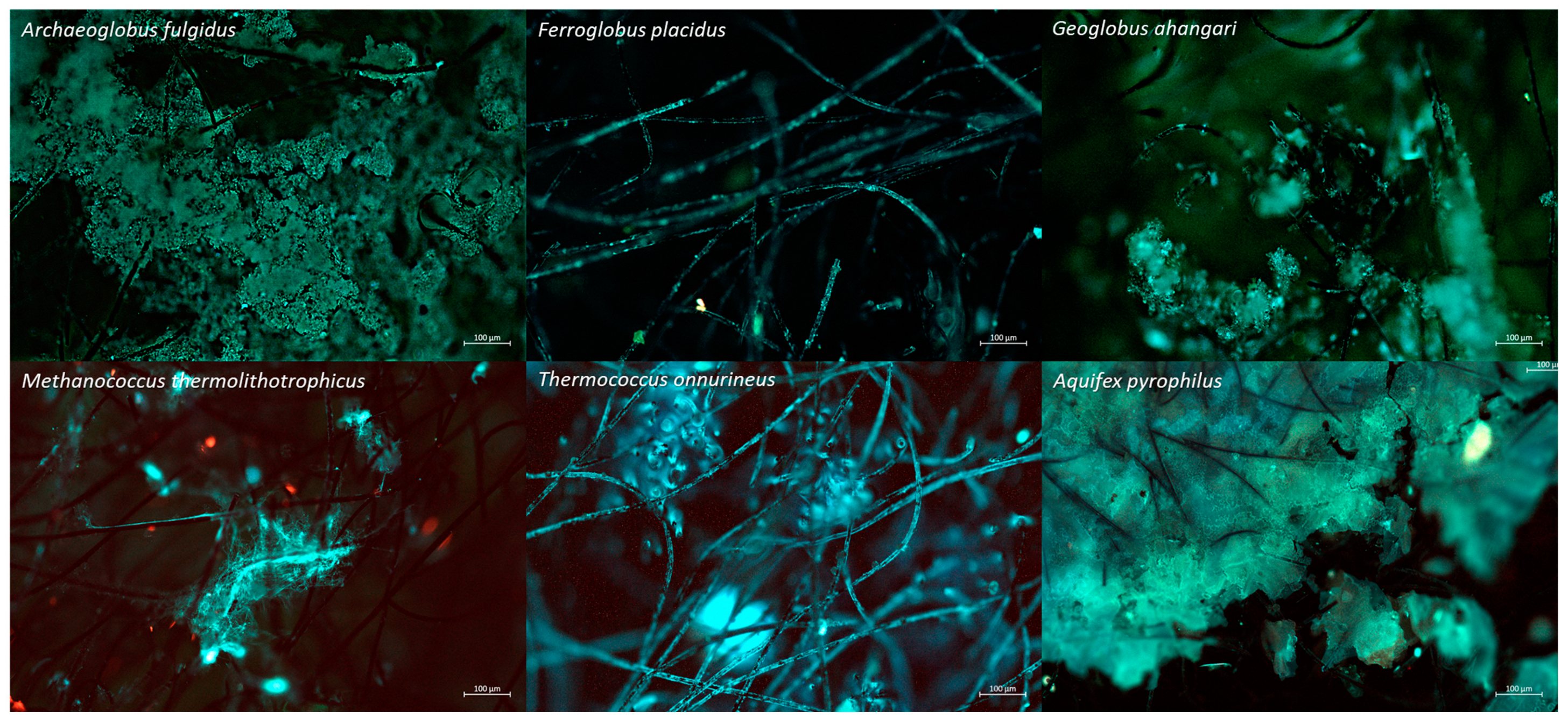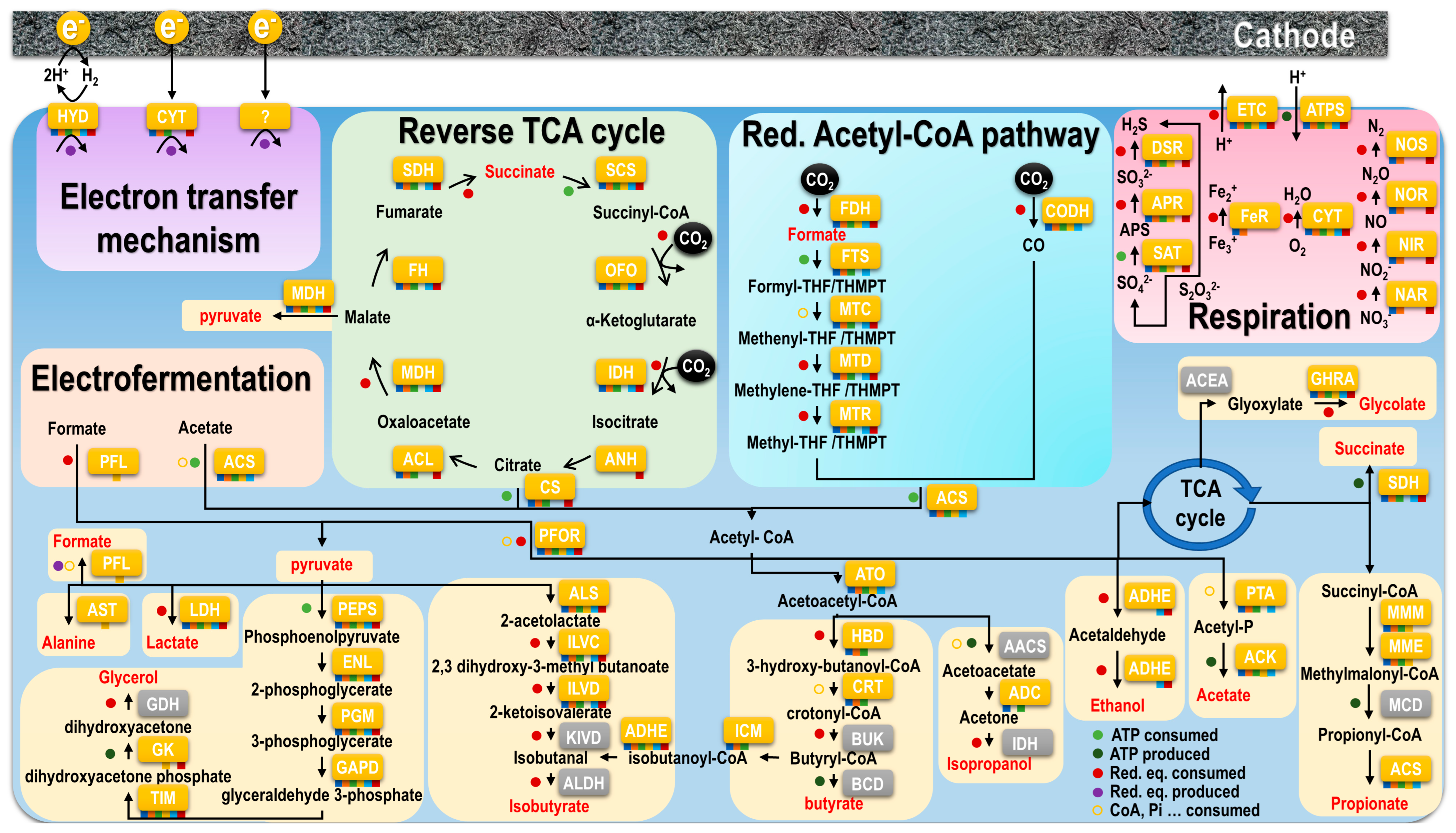Screening for Hyperthermophilic Electrotrophs for the Microbial Electrosynthesis of Organic Compounds
Abstract
1. Introduction
2. Materials and Methods
2.1. Media and Precultures
2.2. Microbial Electrochemical System
| Strain | Electron Acceptors/Carbon Source | pH Range | Coulombs | HPLC (mM) | IC (mM) | qPCR (Log10 rRNA Copies·mL−1) | ||||||||
|---|---|---|---|---|---|---|---|---|---|---|---|---|---|---|
| Succinic Acid | Lactic Acid | Formic Acid | Acetic Acid | Propionic Acid | Isobutyric Acid | Nitrate | Sulfate | Thiosulfate | ||||||
| Archaeoglobus fulgidus | AF | SO4, S2O3/CO2 | 5.5–7.5 | 202 ± 41 | NA | NA | 0.06 ± 0.05 | 0.02 ± 0.03 | 0.04 ± 0.05 | 0.07 ± 0.10 | - | −3.59 ± 1.56 | −6.98 ± 1.01 | 7.59 ± 0.87 |
| Archaeoglobus profundus | APr | SO4, S2O3/CO2 | 4.5–7.5 | 272 ± 56 | NA | NA | 0.08 ± 0.03 | - | 0.09 ± 0.13 | 0.04 ± 0.06 | - | −3.43 ± 3.40 | −5.04 ± 2.46 | 7.45 ± 0.40 |
| Ferroglobus placidus | FP | NO3, S2O3, Fe(III)Am/CO2 | 6.0–8.5 | 148 ± 38 | NA | NA | 0.01 ± 0.01 | 0.03 ± 0.04 | 0.01 ± 0.02 | 0.28 ± 0.45 | −4.70 ± 7.71 | - | −5.98 ± 4.68 | 5.18 ± 0.34 |
| Geoglobus ahangari | GA | NO3, Fe(III)Am/CO2 | 5.0–7.6 | 113 ± 13 | 0.05 ± 0.04 | - | 0.06 ± 0.04 | 0.09 ± 0.15 | 0.05 ± 0.02 | - | −9.53 ± 0.09 | - | - | 8.15 ± 0.26 |
| Thermococcus onnurineus | TO | -/CO2, acetate | 5.0–9.0 | 113 ± 25 | 0.06 ± 0.05 | 0.06 ± 0.11 | 4.43 ± 0.06 | −4.62 ± 2.16 | 0.09 ± 0.08 | 0.40 ± 0.68 | - | - | - | 7.62 ± 0.90 |
| Thermococcus kodakarensis | TK | -/CO2, acetate | 5.0–9.0 | 78 ± 31 | 0.05 ± 0.08 | 0.06 ± 0.04 | 4.07 ± 0.03 | −6.41 ± 0.85 | 0.09 ± 0.06 | 0.82 ± 0.34 | - | - | - | 5.35 ± 1.14 |
| Thermococcus litoralis | TL | -/CO2, acetate | 6.2–8.5 | 77 ± 21 | 0.04 ± 0.03 | 0.18 ± 0.31 | 4.10 ± 0.07 | −6.05 ± 0.73 | 0.01 ± 0.02 | 0.26 ± 0.44 | - | - | - | 4.57 ± 1.03 |
| Methanocaldococcus jannaschii | MJ | -/CO2 | 5.2–7 | 70 ± 29 | 0.10 ± 0.13 | 0.03 ± 0.05 | 0.08 ± 0.05 | 0.04 ± 0.06 | 0.01 ± 0.02 | 0.31 ± 0.33 | - | - | - | 4.08 ± 0.46 |
| Methanococcus thermolithotrophicus | MT | -/CO2 | 6.0–8.0 | 105 ± 40 | 0.04 ± 0.07 | 0.04 ± 0.05 | 0.08 ± 0.07 | 0.03 ± 0.04 | 0.02 ± 0.03 | 0.12 ± 0.21 | - | - | - | 3.88 ± 1.03 |
| Aquifex pyrophilus | APy | NO3, O2/CO2 | 5.4–7.5 | 172 ± 105 | 0.03 ± 0.05 | - | 0.04 ± 0.02 | 0.27 ± 0.42 | 0.06 ± 0.04 | 0.42 ± 0.69 | −10.14 ± 0.65 | - | - | 8.54 ± 0.94 |
| Aquifex aeolicus | AA | S2O3, O2/CO2 | 5.4–7.5 | 96 ± 21 | NA | NA | 0.01 ± 0.01 | 0.04 ± 0.03 | 0.05 ± 0.03 | 0.05 ± 0.08 | - | - | −6.68 ± 3.18 | 6.53 ± 1.21 |
| Abiotic control | - | SO4, S2O3, NO3, O2, Fe(III)Am/CO2, acetate | 35 ± 5 | NA | NA | - | −1.50 ± 0.21 | 0.01 ± 0.01 | 0.03 ± 0.01 | −0.75 ± 0.23 | −0.38 ± 0.47 | −0.91 ± 0.52 | - | |
2.3. Fluorescence Microscopy
2.4. Biofilm Quantification by Means of qPCR
2.5. Analysis of Produced Organic Compounds
3. Results
3.1. Screening Experiments
3.2. Long-Term Experiments
3.2.1. Current Consumption and pH
3.2.2. Organic Compound Productions
3.2.3. Coulombic Efficiency
3.2.4. Soluble Electron Acceptors
3.2.5. Biofilm Observation and Quantification
4. Discussion
4.1. Electrotrophy of (Hyper) Thermophilic Strains
4.2. Electrosynthesis Pathways to Valuable Organic Compounds
4.2.1. Carbon Fixation Pathways and Intermediates
4.2.2. Acetyl-CoA and Further down the Road of Anabolism
4.2.3. Electrofermentation by Thermococcales
4.2.4. Respiration and Electron Acceptor Availability
4.3. Biotechnological Application
Supplementary Materials
Author Contributions
Funding
Institutional Review Board Statement
Informed Consent Statement
Data Availability Statement
Acknowledgments
Conflicts of Interest
References
- Rabaey, K.; Rozendal, R.A. Microbial Electrosynthesis—Revisiting the Electrical Route for Microbial Production. Nat. Rev. Microbiol. 2010, 8, 706–716. [Google Scholar] [CrossRef] [PubMed]
- Prévoteau, A.; Carvajal-Arroyo, J.M.; Ganigué, R.; Rabaey, K. Microbial Electrosynthesis from CO2: Forever a Promise? Curr. Opin. Biotechnol. 2020, 62, 48–57. [Google Scholar] [CrossRef] [PubMed]
- Chien, A.; Edgar, D.B.; Trela, J.M. Deoxyribonucleic Acid Polymerase from the Extreme Thermophile Thermus Aquaticus. J. Bacteriol. 1976, 127, 1550–1557. [Google Scholar] [CrossRef] [PubMed]
- Nakamura, R.; Takashima, T.; Kato, S.; Takai, K.; Yamamoto, M.; Hashimoto, K. Electrical Current Generation across a Black Smoker Chimney. Angew. Chem. 2010, 122, 7858–7860. [Google Scholar] [CrossRef]
- Yamamoto, M.; Nakamura, R.; Kasaya, T.; Kumagai, H.; Suzuki, K.; Takai, K. Spontaneous and Widespread Electricity Generation in Natural Deep-Sea Hydrothermal Fields. Angew. Chem. 2017, 129, 5819–5822. [Google Scholar] [CrossRef]
- Pillot, G.; Amin Ali, O.; Davidson, S.; Shintu, L.; Godfroy, A.; Combet-Blanc, Y.; Bonin, P.; Liebgott, P.P. Identification of Enriched Hyperthermophilic Microbial Communities from a Deep-Sea Hydrothermal Vent Chimney under Electrolithoautotrophic Culture Conditions. Sci. Rep. 2021, 11, 14782. [Google Scholar] [CrossRef]
- Pillot, G.; Amin Ali, O.; Davidson, S.; Shintu, L.; Combet-Blanc, Y.; Godfroy, A.; Bonin, P.; Liebgott, P.P. Evolution of Thermophilic Microbial Communities from a Deep-Sea Hydrothermal Chimney under Electrolithoautotrophic Conditions with Nitrate. Microorganisms 2021, 9, 2475. [Google Scholar] [CrossRef]
- Reiner, J.E.; Geiger, K.; Hackbarth, M.; Fink, M.; Lapp, C.J.; Jung, T.; Dötsch, A.; Hügler, M.; Wagner, M.; Hille-Reichel, A.; et al. From an Extremophilic Community to an Electroautotrophic Production Strain: Identifying a Novel Knallgas Bacterium as Cathodic Biofilm Biocatalyst. ISME J. 2020, 14, 1125–1140. [Google Scholar] [CrossRef]
- Jourdin, L.; Burdyny, T. Microbial Electrosynthesis: Where Do We Go from Here? Trends Biotechnol. 2021, 39, 359–369. [Google Scholar] [CrossRef]
- Pillot, G.; Sunny, S.; Comes, V.; Kerzenmacher, S. Optimization of Growth and Electrosynthesis of PolyHydroxyAlkanoates by the Thermophilic Bacterium Kyrpidia Spormannii. Bioresour. Technol. Rep. 2022, 17, 100949. [Google Scholar] [CrossRef]
- Trujillo, M.E.; Dedysh, S.; DeVos, P.; Hedlund, B.; Kämpfer, P.; Rainey, F.A.; Whitman, W.B. (Eds.) Bergey’s Manual of Systematics of Archaea and Bacteria; Wiley: New York, NY, USA, 2015. [Google Scholar]
- Yu, L.; Yuan, Y.; Tang, J.; Zhou, S. Thermophilic Moorella Thermoautotrophica-Immobilized Cathode Enhanced Microbial Electrosynthesis of Acetate and Formate from CO2. Bioelectrochemistry 2017, 117, 23–28. [Google Scholar] [CrossRef] [PubMed]
- Faraghiparapari, N.; Zengler, K. Production of Organics from CO2 by Microbial Electrosynthesis (MES) at High Temperature. J. Chem. Technol. Biotechnol. 2017, 92, 375–381. [Google Scholar] [CrossRef]
- Yang, H.Y.; Hou, N.N.; Wang, Y.X.; Liu, J.; He, C.S.; Wang, Y.R.; Li, W.H.; Mu, Y. Mixed-Culture Biocathodes for Acetate Production from CO2 Reduction in the Microbial Electrosynthesis: Impact of Temperature. Sci. Total Environ. 2021, 790, 148128. [Google Scholar] [CrossRef] [PubMed]
- Soussan, L.; Riess, J.; Erable, B.; Delia, M.L.; Bergel, A. Electrochemical Reduction of CO2 Catalysed by Geobacter Sulfurreducens Grown on Polarized Stainless Steel Cathodes. Electrochem. Commun. 2013, 28, 27–30. [Google Scholar] [CrossRef]
- Flores, A.D.; Choi, H.G.; Martinez, R.; Onyeabor, M.; Ayla, E.Z.; Godar, A.; Machas, M.; Nielsen, D.R.; Wang, X. Catabolic Division of Labor Enhances Production of D-Lactate and Succinate From Glucose-Xylose Mixtures in Engineered Escherichia Coli Co-Culture Systems. Front. Bioeng. Biotechnol. 2020, 8, 329. [Google Scholar] [CrossRef]
- Steffens, L.; Pettinato, E.; Steiner, T.M.; Mall, A.; König, S.; Eisenreich, W.; Berg, I.A. High CO2 Levels Drive the TCA Cycle Backwards towards Autotrophy. Nature 2021, 592, 784–788. [Google Scholar] [CrossRef]
- Kanehisa, M.; Goto, S. KEGG: Kyoto Encyclopedia of Genes and Genomes. Nucleic Acids Res. 2000, 28, 27–30. [Google Scholar] [CrossRef]
- Vassilev, I.; Hernandez, P.A.; Batlle-Vilanova, P.; Freguia, S.; Krömer, J.O.; Keller, J.; Ledezma, P.; Virdis, B. Microbial Electrosynthesis of Isobutyric, Butyric, Caproic Acids, and Corresponding Alcohols from Carbon Dioxide. ACS Sustain. Chem. Eng. 2018, 6, 8485–8493. [Google Scholar] [CrossRef]
- Gibson, M.I.; Chen, P.Y.T.; Drennan, C.L. A Structural Phylogeny for Understanding 2-Oxoacid Oxidoreductase Function. Curr. Opin. Struct. Biol. 2016, 41, 54–61. [Google Scholar] [CrossRef]
- Siebers, B.; Schönheit, P. Unusual Pathways and Enzymes of Central Carbohydrate Metabolism in Archaea. Curr. Opin. Microbiol. 2005, 8, 695–705. [Google Scholar] [CrossRef]
- Bagnato, G.; Iulianelli, A.; Sanna, A.; Basile, A. Glycerol Production and Transformation: A Critical Review with Particular Emphasis on Glycerol Reforming Reaction for Producing Hydrogen in Conventional and Membrane Reactors. Membranes 2017, 7, 17. [Google Scholar] [CrossRef] [PubMed]
- Neish, A.C.; Blackwood, A.C.; Ledingham, G.A. Dissimilation of Glucose by Bacillus Subtilis (Ford’s Strain). Can. J. Res. 1945, 23, 290–296. [Google Scholar] [CrossRef] [PubMed]
- Nevoigt, E.; Stahl, U. Osmoregulation and Glycerol Metabolism in the Yeast Saccharomyces Cerevisiae. FEMS Microbiol. Rev. 1997, 21, 231–241. [Google Scholar] [CrossRef] [PubMed]
- Lee, C.S.; Aroua, M.K.; Wan Daud, W.A.; Cognet, P.; Pérès, Y.; Ajeel, M.A. Selective Electrochemical Conversion of Glycerol to Glycolic Acid and Lactic Acid on a Mixed Carbon-Black Activated Carbon Electrode in a Single Compartment Electrochemical Cell. Front. Chem. 2019, 7, 110. [Google Scholar] [CrossRef] [PubMed]
- Gonzalez-Garcia, R.A.; McCubbin, T.; Navone, L.; Stowers, C.; Nielsen, L.K.; Marcellin, E. Microbial Propionic Acid Production. Fermentation 2017, 3, 21. [Google Scholar] [CrossRef]
- Matthies, C.; Schink, B. Reciprocal Isomerization of Butyrate and Isobutyrate by the Strictly Anaerobic Bacterium Strain WoG13 and Methanogenic Isobutyrate Degradation by a Defined Triculture. Appl. Environ. Microbiol. 1992, 58, 1435–1439. [Google Scholar] [CrossRef]
- Imanaka, H.; Yamatsu, A.; Fukui, T.; Atomi, H.; Imanaka, T. Phosphoenolpyruvate Synthase Plays an Essential Role for Glycolysis in the Modified Embden-Meyerhof Pathway in Thermococcus Kodakarensis. Mol. Microbiol. 2006, 61, 898–909. [Google Scholar] [CrossRef]
- Shikata, K.; Fukui, T.; Atomi, H.; Imanaka, T. A Novel ADP-Forming Succinyl-CoA Synthetase in Thermococcus Kodakaraensis Structurally Related to the Archaeal Nucleoside Diphosphate-Forming Acetyl-CoA Synthetases. J. Biol. Chem. 2007, 282, 26963–26970. [Google Scholar] [CrossRef]
- Kim, Y.J.; Lee, H.S.; Kim, E.S.; Bae, S.S.; Lim, J.K.; Matsumi, R.; Lebedinsky, A.V.; Sokolova, T.G.; Kozhevnikova, D.A.; Cha, S.S.; et al. Formate-Driven Growth Coupled with H2 Production. Nature 2010, 467, 352–355. [Google Scholar] [CrossRef]
- Kozhevnikova, D.A.; Taranov, E.A.; Lebedinsky, A.V.; Bonch-Osmolovskaya, E.A.; Sokolova, T.G. Hydrogenogenic and Sulfidogenic Growth of Thermococcus Archaea on Carbon Monoxide and Formate. Microbiol. Russ. Fed. 2016, 85, 400–410. [Google Scholar] [CrossRef]
- Sánchez-Andrea, I.; Guedes, I.A.; Hornung, B.; Boeren, S.; Lawson, C.E.; Sousa, D.Z.; Bar-Even, A.; Claassens, N.J.; Stams, A.J.M. The Reductive Glycine Pathway Allows Autotrophic Growth of Desulfovibrio Desulfuricans. Nat. Commun. 2020, 11, 5090. [Google Scholar] [CrossRef] [PubMed]
- Le Guellec, S.; Leroy, E.; Courtine, D.; Godfroy, A.; Roussel, E.G. H2-Dependent Formate Production by Hyperthermophilic Thermococcales: An Alternative to Sulfur Reduction for Reducing-Equivalents Disposal. ISME J. 2021, 15, 3423–3436. [Google Scholar] [CrossRef] [PubMed]
- Ying, X.; Ma, K. Characterization of a Zinc-Containing Alcohol Dehydrogenase with Stereoselectivity from the Hyperthermophilic Archaeon Thermococcus Guaymasensis. J. Bacteriol. 2011, 193, 3009–3019. [Google Scholar] [CrossRef] [PubMed]
- Miroshnichenko, M.L.; Hippe, H.; Stackebrandt, E.; Kostrikina, N.A.; Chernyh, N.A.; Jeanthon, C.; Nazina, T.N.; Belyaev, S.S.; Bonch-Osmolovskaya, E.A. Isolation and Characterization of Thermococcus Sibiricus Sp. Nov. from a Western Siberia High-Temperature Oil Reservoir. Extremophiles 2001, 5, 85–91. [Google Scholar] [CrossRef]
- Miroshnichenko, M.L.; Bonch-Osmolovskaya, E.A.; Neuner, A.; Kostrikina, N.A.; Chernych, N.A.; Alekseev, V.A. Thermococcus Stetteri Sp. Nov., a New Extremely Thermophilic Marine Sulfur-Metabolizing Archaebacterium. Syst. Appl. Microbiol. 1989, 12, 257–262. [Google Scholar] [CrossRef]
- Smith, J.A.; Aklujkar, M.; Risso, C.; Leang, C.; Giloteaux, L.; Holmes, D.E. Mechanisms Involved in Fe(III) Respiration by the Hyperthermophilic Archaeon Ferroglobus Placidus. Appl. Environ. Microbiol. 2015, 81, 2735–2744. [Google Scholar] [CrossRef]
- Deckert, G.; Warren, P.V.; Gaasterland, T.; Young, W.G.; Lenox, A.L.; Graham, D.E.; Overbeek, R.; Snead, M.A.; Keller, M.; Aujay, M.; et al. The Complete Genome of the Hyperthermophilic Bacterium Aquifex Aeolicus. Nature 1998, 392, 353–358. [Google Scholar] [CrossRef]
- Hafenbradl, D.; Keller, M.; Dirmeier, R.; Rachel, R.; Roßnagel, P.; Burggraf, S.; Huber, H.; Stetter, K.O. Ferroglobus Placidus Gen. Nov., Sp. Nov., a Novel Hyperthermophilic Archaeum That Oxidizes Fe2+ at Neutral PH under Anoxic Conditions. Arch. Microbiol. 1996, 166, 308–314. [Google Scholar] [CrossRef]
- Amend, J.P.; Shock, E.L. Energetics of Overall Metabolic Reactions of Thermophilic and Hyperthermophilic Archaea and Bacteria. FEMS Microbiol. Rev. 2001, 25, 175–243. [Google Scholar] [CrossRef]
- Dessì, P.; Rovira-Alsina, L.; Sánchez, C.; Dinesh, G.K.; Tong, W.; Chatterjee, P.; Tedesco, M.; Farràs, P.; Hamelers, H.M.V.; Puig, S. Microbial Electrosynthesis: Towards Sustainable Biorefineries for Production of Green Chemicals from CO2 Emissions. Biotechnol. Adv. 2021, 46, 107675. [Google Scholar] [CrossRef]
- Srikanth, S.; Singh, D.; Vanbroekhoven, K.; Pant, D.; Kumar, M.; Puri, S.K.; Ramakumar, S.S.V. Electro-Biocatalytic Conversion of Carbon Dioxide to Alcohols Using Gas Diffusion Electrode. Bioresour. Technol. 2018, 265, 45–51. [Google Scholar] [CrossRef] [PubMed]
- Dessie, W.; Luo, X.; Wang, M.; Feng, L.; Liao, Y.; Wang, Z.; Yong, Z.; Qin, Z. Current Advances on Waste Biomass Transformation into Value-Added Products. Appl. Microbiol. Biotechnol. 2020, 104, 4757–4770. [Google Scholar] [CrossRef] [PubMed]
- Werpy, T.; Petersen, G. Top Value Added Chemicals from Biomass Volume I; US Department of Energy: Oak Ridge, TN, USA, 2004. [CrossRef]






Publisher’s Note: MDPI stays neutral with regard to jurisdictional claims in published maps and institutional affiliations. |
© 2022 by the authors. Licensee MDPI, Basel, Switzerland. This article is an open access article distributed under the terms and conditions of the Creative Commons Attribution (CC BY) license (https://creativecommons.org/licenses/by/4.0/).
Share and Cite
Popall, R.M.; Heussner, A.; Kerzenmacher, S.; Liebgott, P.-P.; Pillot, G. Screening for Hyperthermophilic Electrotrophs for the Microbial Electrosynthesis of Organic Compounds. Microorganisms 2022, 10, 2249. https://doi.org/10.3390/microorganisms10112249
Popall RM, Heussner A, Kerzenmacher S, Liebgott P-P, Pillot G. Screening for Hyperthermophilic Electrotrophs for the Microbial Electrosynthesis of Organic Compounds. Microorganisms. 2022; 10(11):2249. https://doi.org/10.3390/microorganisms10112249
Chicago/Turabian StylePopall, Rabja Maria, Alenica Heussner, Sven Kerzenmacher, Pierre-Pol Liebgott, and Guillaume Pillot. 2022. "Screening for Hyperthermophilic Electrotrophs for the Microbial Electrosynthesis of Organic Compounds" Microorganisms 10, no. 11: 2249. https://doi.org/10.3390/microorganisms10112249
APA StylePopall, R. M., Heussner, A., Kerzenmacher, S., Liebgott, P.-P., & Pillot, G. (2022). Screening for Hyperthermophilic Electrotrophs for the Microbial Electrosynthesis of Organic Compounds. Microorganisms, 10(11), 2249. https://doi.org/10.3390/microorganisms10112249








